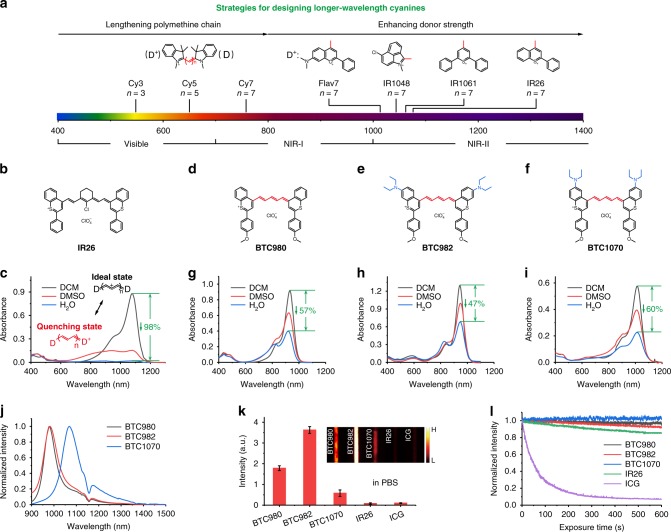Fig. 1.
Molecular design and spectra properties of NIR-II BTCs. a Schematic illustration shows the general strategies for tuning absorption wavelength of cyanines: lengthening polymethine chain (n denotes the number of methine unit) leads to bathochromic shift; however, enhancing donor (D) strength by heterocycle modification is a more-effective strategy to afford NIR-II absorbing/emitting cyanines. b, c Chemical structure b and absorption spectra c of IR26 in dichloromethane (DCM), dimethyl sulfoxide (DMSO) and H2O (phospholipid micelle formation). The ideal state, namely cyanine limit, presenting equalized charge and minimal bond length alternation in a symmetric cyanine structure, is characterized by intense and narrow absorption in nonpolar solvents such as DCM. Polar solvents such as DMSO and H2O break the symmetry, leading to weak and broad absorption, corresponding to a quenching state called as beyond the cyanine limit. d–f Rational design of pentamethine benzothiopyrylium cyanines (d, BTC980, e, BTC982, and f BTC1070) by shortening polymethine chain (red) and introducing electron-donating diethylamino groups (blue). g–i Intense and sharp absorption spectra of BTC980 g, BTC982 h, and BTC1070 i (5 μm) in dichloromethane, dimethyl sulfoxide, and H2O (phospholipid micelle formation). j Normalized fluorescence spectra of BTC980, BTC982, and BTC1070 in DCM. The ~ 1150 nm dips are caused by solvent absorption (Supplementary Figure 6). k NIR-II (1000–1700 nm) brightness comparison of equimolar (10 μm) BTC980, BTC982, BTC1070, IR26, and ICG in PBS (pH 7.4) on an InGaAs camera. Inset: fluorescence images of capillaries filled with fluorophores. Color bar ranges from 0 to 30,000 for each image. The detailed imaging parameters for each image are listed in Supplementary Table 1. Source data are provided as a Source Data file. l Photostability comparison of all fluorophores (5 μm) in PBS (pH 7.4) under continuous-wave laser exposure (ICG: 808 nm, BTC980: 915 nm, BTC982: 940 nm, BTC1070 and IR26: 1064 nm) at a fluence rate of 2.3 W cm−2. The bars in k represent mean ± s.d. derived from n = 3 replicated measurements of every pixel of the capillaries

